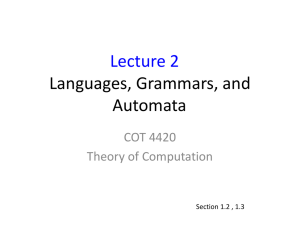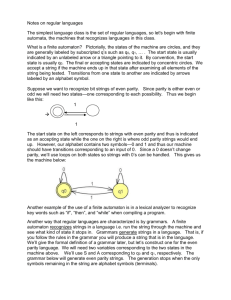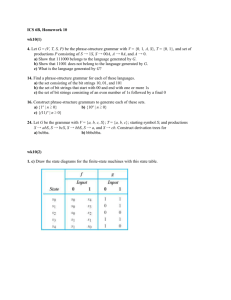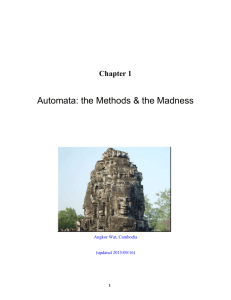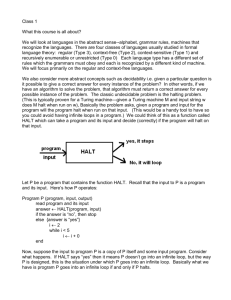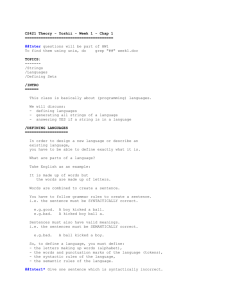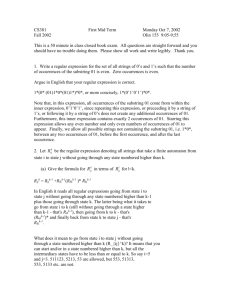Grammars & Languages
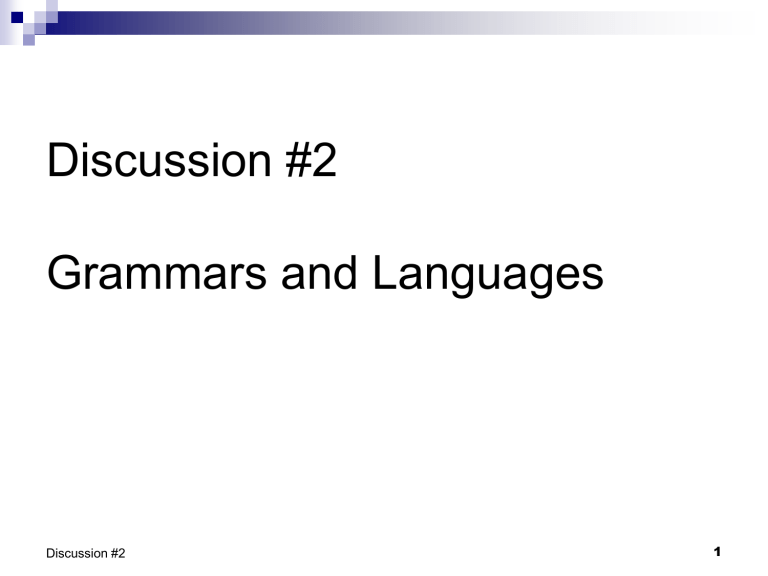
Discussion #2
Grammars and Languages
Discussion #2
1
Topics
Set basics
Programming languages / compilers
Grammars as set generators
Languages as defined by grammars
Discussion #2
2
Set Basics
Set = unordered collection of distinct items
Notation: curly braces enclose items, e.g. {0, a, xy}
Unordered: {0, a, xy} = {a, xy, 0}
Distinct: {0, 0, a, xy} is not a set; contains duplicates
Can name sets: A = {0, a, xy}; B = {a, b}
Empty set: { } or
Common operations
Element: 0
{0, a, xy}; 0
A; 0
B; aa
A
Count or cardinality: |{0, a, xy}| = 3; |A| = 3; |B| = 2
Union: A
B = {0, a, xy, b}
Intersection: A
B = {a}
Difference: A
B = {0, xy}; B
A = {b}
Subset
Subset: {0, xy}
{0, a, xy};
A; A
A; B
A
Proper Subset: {0, xy}
{0, a, xy};
A; A
A
Discussion #2
3
Programming Language
Specification
Define the alphabet
a set of symbols that can be used to construct programs
Define the set of all correct programs
Define the “meaning” of all correct programs
Discussion #2
4
Alphabets
An alphabet (or vocabulary) V is a nonempty set of symbols.
Examples:
V
1
= {0, 1}
V
2
= { a , b , … , z , …}
Discussion #2
5
Strings
An element of an alphabet set is called a letter , character , or symbol
A string over an alphabet is a sequence of symbols from the alphabet
A string is also called a sequence , word ,
or sentence
Length of a string
is denoted by #
or
|
|.
6
Discussion #2
Strings
A string of m symbols is called a string of length m.
If m = 0, the string is called the empty string and is denoted by
.
The set of strings over an alphabet V of length n is denoted by V n .
The set of all strings is V* .
The set of all nonempty strings is V + .
If V = {0, 1, 2, 3, x , y , z , +, *, ), (} then
V 1 = V
V 2 = {00, 01, … 0(, … ((}
V 0 = {
}
V* = All combinations of all lengths
V + = V*
{
}
7
Discussion #2
Languages
Definition: A language L is a subset of V* , i.e. L
V* .
A programming language can be thought of as the set of all possible programs, where a program is a valid string (a very long string).
Programs with syntax errors are not in the set.
A language can be finite or infinite.
Programming languages are infinite.
i.e. there are an infinite number of programs.
8
Discussion #2
Language Representation
A finite language can be specified by enumerating all of its sentences.
An infinite language cannot be specified by enumeration, but can be specified by a generative device called a grammar.
9
Discussion #2
Grammars
A grammar is a way to specify the set of all legal sentences of a language (i.e. to specify the set of all legal programs of a programming language).
Grammars are defined recursively (i.e. some elements are defined in terms of themselves).
Recursive definitions are also called inductive definitions (i.e. they induce, rather than enumerate, the set of strings).
10
Discussion #2
Grammar: Inductive Definition
Let’s define a simple kind of arithmetic expression, A.
Basis Rules:
A Variable is an A.
An Integer is an A.
Inductive Rules:
If E
1
If E
1 and E
2 and E
2 are A’s, so is (E
1
+ E
2
).
are A’s, so is (E
1
* E
2
).
Examples: x, y, 3, 12, (x + y), (z * (x + y)), ((z * (x + y)) + 12)
Not Examples:
*3, (x ++ y), x + y
Discussion #2
11
Writing Inductive Definitions as
Productions
Productions use terminal symbols , nonterminal symbols (also called syntactical categories ) and meta-symbols to define basis and inductive rules.
For our example:
A
V
A
I
A
(A + A)
A
(A * A)
Basis Rules
Inductive
Rules
12
Discussion #2
Full Grammar for Simple
Arithmetic Expressions
Let’s define all non-terminals:
1.
2.
3.
4.
5.
A
V | I | (A + A) | (A * A)
V
L | VL | VD
I
D | ID
D
0 | 1 | 2 | 3 | 4 | 5 | 6 | 7 | 8 | 9
L
x | y | z
Discussion #2
13
1.
A
V | I | (A + A) | (A * A)
2.
V
L | VL | VD
3.
I
D | ID
4.
D
0 | 1 | 2 | 3 | 4 | 5 | 6 | 7 | 8 | 9
5.
L
x | y | z
A
( A
( ( A * A
+ A )
) + A )
( ( A * ( A + A ) ) + I )
( ( V * ( V + V ) ) + I D )
( ( L * ( L + L ) ) + D D )
( ( z * ( x + y ) ) + 1 2 )
Discussion #2
14
Lexical Analyzers and Parsers
Lexical analyzers
Input: symbols of length 1
Output: classified tokens
Parsers
Input: classified tokens
Output: parse tree (syntactically correct program)
Discussion #2
15
Simple English Grammar
Symbols:
S: sentence
V: verb
O: object
A: article
N: noun
SP: subject phrase
VP: verb phrase
NP: noun phrase
Discussion #2
Rules:
S
SP VP
SP
A N
A
a | the
N
monkey | banana | tree
VP
V O
V
ate | climbs
O
NP
NP
A N
16
Parsing an English sentence
“a monkey ate the banana” sentence subject phrase verb phrase article a noun monkey verb ate article the object noun phrase noun banana
17
Discussion #2
